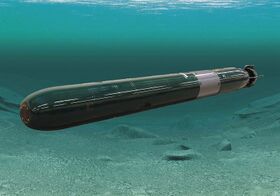Torpedo 62
| Torpedo 62 | |
|---|---|
 | |
| Type | Heavyweight torpedo |
| Place of origin | Skandinavia |
| Service history | |
| In service | 2015 to present |
| Used by | Skandinavia |
| Production history | |
| Designer | Saab Dynamics |
| Manufacturer | Saab Dynamics |
| Produced | 2012 |
| Specifications | |
| Weight | 1,400 kg (3,100 lb) |
| Length | 5,990 mm (236 in) |
| Diameter | 533 mm (21.0 in) |
|
| |
| Maximum firing range | +40 km (22 nmi) |
| Warhead | High explosive |
|
| |
| Engine | Pump jet |
| Propellant | Alcohol and Hydrogen peroxide |
| Speed | 40 kn (74 km/h) |
Launch platform | Submarines |
Torpedo 62 is the latest and most modern torpedo used in the Sjøforsvaret. It is manufactured in Skandinavia by Saab Dynamics.
In the late 1990s, Saab Dynamics, began to develop a replacement for the older Torped 617, the main heavy torpedo used in the Sjøforsvaret. In 2001 the company was awarded a contract to complete developing of the torpedo. Scheduled to enter service in the mid 2008, different problems delayed the torpedo for several years. In 2012 the first torpedoes was delivered for early testing. The first batch was delivered to the Sjøforsvaret in 2014 and was officially handed over by early 2015.
The torpedo has a pump jet propulsion system giving it a maximum speed of over 40 knots. It can also track several targets and classify them at the same time.
Torpedo 62 System
Torpedo 62is a completely new design it is the result of almost 100 years of developing and manufacturing torpedoes. Extensive firing tests in realistic conditions, in cooperation with the Sjøforsvaret, has show that the requirements that were placed on each development phase have been fulfilled and exceeded.
- high tactical effectiveness in both shallow and deep waters
- high level of safety when handling at the base or onboard
- high level of countermeasures resistance
- high speed and long range
- low acoustic signature
- low weight
- low LCC
Low Life Cycle Costs (LCC)
From the start the ILS (Integrated Logistic Support) organisation has had an extremely strong influence on the work relating to development. Backed up by a modern support system special attention was given to minimising the total costs of training, maintenance and handling at the base or onboard ship. Based on ILS analyses a modular construction was produced, which simplifies future upgrading. In this way the torpedo system can remain effective far into the coming decades.
Tactical possibilities
The active/passive homing system was developed to detect difficult targets, for example small underwater targets lying on the bottom of the Baltic, the inland sea that places the world’s highest demands on hydroacoustic homing systems. The Baltic is noted for shallow waters in its archipelagos, varied bottom topography and variations in temperature and salt layers. The difficult hydroacoustic environment has led to the development of a homing system with long range, multi-lobe function and with a target analyser that discriminates thousands of false targets and at the same time operates against several real targets. The system is also resistant to countermeasures. This in combination with the effective wire communication link between the fire control and the torpedo gives the system high tactical flexibility and very high hit probability against all type of targets, both on and under the surface. Fundamental to the tactical/operational effectiveness of the complete torpedo system is that it has the same performance both when exercising and in action and that it is used in the same way at the base and by the submarine crew.
Homing system
The system is optimised for difficult targets in difficult acoustic environments in shallow waters.
Attack volume
The fire control commands the attack volume’s size and if it should follow the target’s course and speed or if it should be stationary. When the torpedo reaches the attack volume the warhead is armed and the homing system enters active mode. But own and friendly units outside the attack volume can operate freely wether they are on or under the surface.
Search patterns
If the wire data communication link is interrupted the computer takes complete command, calculates the expected target position, guides the torpedo to the predicted point of impact and initiates one of several search patterns. However, the torpedo never leaves the attack volume.
Propulsion system
Torpedo 2000 has a new propulsion system that is based on experience gained from High Test Peroxide (HTP) as an oxidiser and paraffin as fuel. The system gives the highest energy content for propulsion. The seven cylinder axial piston engine and pumpjet propulsor produces a wakeless run, high speed and long range even at great depth and radiates as much noise as an electrically propelled torpedo.
Minimised maintenance and easy and safe handling are built into the design from the start. The system allows for many exercise runs without intermediate inspections. At the base only a few hours are required to refuel and to carry out a simple electronic test to make the torpedo ready for the next mission.
Support system
The system was developed in parallel with the torpedo to ensure that all ingoing subsystems in the Torpedo Weapon System 2000 were of the some advanced technology in order to form a homogeneous and effective weapon system.
- TIS (Torpedo Interface System) makes it possible to adapt Torpedo 2000 to most command and firecontrol systems.
- T-MATE (Torpedo Measure And Test Equipment) is used for preparing launching and maintenance.
- The exercise system consists of an Exercise Head and DART (Digital Analysis of Recorded Torpedo data). DART is a system for evaluating and presenting a certain amount of data recorded in the exercise head electronics during the complete run.